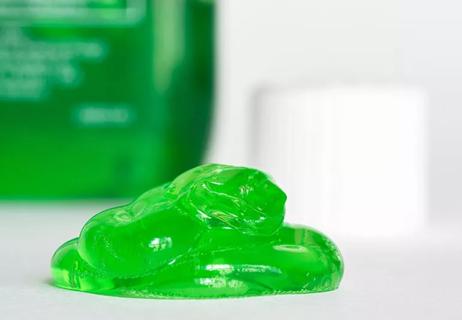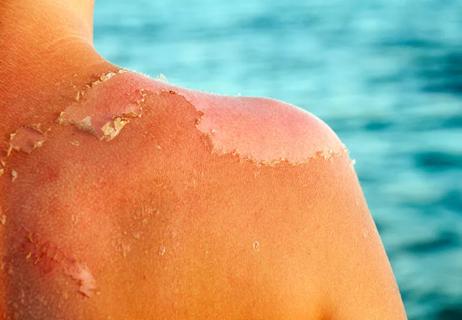Soothe your red, burning skin by applying aloe vera, moisturizing and using a cold compress

Plenty of us have suffered an accidental sunburn. Maybe you didn’t plan to be outdoors and neglected the sunscreen, or maybe you didn’t reapply later in the day or just missed a spot or two.
Advertisement
Cleveland Clinic is a non-profit academic medical center. Advertising on our site helps support our mission. We do not endorse non-Cleveland Clinic products or services. Policy
Whatever it was, your skin is now hot, throbbing and lobster-colored. Now what? You may have heard of different types of relief for sunburn, ranging from aloe vera to cold showers. Which should you try?
Dermatologist Melissa Piliang, MD, talks with us about sunburn relief — and how to prevent a sunburn next time.
Here are a few ways to get sunburn relief:
Unsurprisingly, when your skin feels like it’s on fire, it’s best to throw some water on it. “Take a cool bath or shower to bring the temperature of your skin down,” advises Dr. Piliang. This helps reduce inflammation. But make it short — excessive time in the water dries out your skin. If you’re showering, keep the water pressure gentle, so you don’t put too much pressure on the affected skin.
After you cool down with some water, it’s a good idea to lock in that moisture, too. While your skin is still wet, apply a moisturizer cream or lotion to help seal in moisture, Dr. Piliang instructs. In the first few days after the initial burn, apply moisturizer frequently to limit dryness.
Just be sure not to moisturize your skin until it has cooled off, or you’ll trap the heat and cause more pain and inflammation.
The green gel that comes from an aloe vera plant can actually help soothe and cool down your skin during a sunburn. Because of its anti-inflammatory properties, aloe vera can help calm down your skin and relieve any stinging or discomfort. It’s just a temporary fix — but hey, whatever keeps the burn down until it heals!
Advertisement
Just be sure to go for pure aloe vera gel (straight from the plant) or store-bought gel that doesn’t have any added irritants or fragrances.
Sometimes, the itching from sunburn can be just as irritating as a burn (if not more). But there are ways to alleviate that, too. If you’re feeling itchy, try applying a thin layer of 1% hydrocortisone cream to the sunburned area.
Especially if your burn only affects a smaller area, you can cool it down using a cold compress like a wet towel or washcloth. But stay away from using an ice pack on the burn. While it may seem like a good idea to fight extreme heat with extreme cold, ice can do more harm than good.
“Those cool compresses feel great and provide some relief from the burning sensation,” Dr. Piliang notes. Just gently place it on the burn until your skin feels cooler to the touch.
Sometimes, there’s only so much you can do topically. If you’re still feeling pain and irritation from your sunburn, don’t hesitate to pop a pain reliever if you’re really hurting.
“You can take something for the inflammation, like ibuprofen, naproxen or aspirin,” Dr. Piliang recommends.
Sunburns draw fluids away from other parts of your body to your skin, which can quickly dehydrate you. So, make sure you’re drinking extra water to compensate.
“It’s really important to make sure you’re hydrating well,” Dr. Piliang stresses. “Drink a lot of water. Sports drinks that replenish electrolytes can also help.”
When experiencing a sunburn, knowing how to relieve it is as important as knowing how to not irritate it more.
Here are things to avoid doing when trying to heal a sunburn:
First things first: “Get out of the sun right away and get your skin cooled down,” Dr. Piliang states. Oftentimes, we only notice a sunburn when we’re back at home and look in the mirror — eek! But if you notice that your skin is red and irritated while you’re still outside, it’s best to get into some shade quickly so you don’t make the burn worse.
Skip ointments and petroleum jelly, which trap heat. And avoid topical treatments ending in “-caine,” like benzocaine and lidocaine, which can cause allergic reactions that can worsen your inflammation.
“Pass on any creams that include alcohol, which will dry out your skin and make it harder to heal,” cautions Dr. Piliang.
It may seem obvious, but avoid touching your sunburn at any stage. Depending on the severity of the burn, even the slightest touch can cause more pain and irritation. And even though you might be tempted to, don’t touch those sunburn blisters either.
Advertisement
“To prevent infection and scarring, let blisters heal on their own,” advises Dr. Piliang.
Sometimes, at-home remedies don’t cut it. If you’re noticing that your sunburn isn’t healing or feeling any better, don’t avoid the issue. In some cases, seeking medical attention is the best bet.
“Call your doctor if you have blisters over a large area, you’re in a lot of pain or you’ve developed a fever, chills, dizziness or confusion,” says Dr. Piliang.
Next time you’re headed outside, make sure you take these preventive measures. Trust us, your skin will thank you if you take a couple of minutes to be extra careful.
Here’s what you can do to prevent a sunburn when you’re out and about this summer:
Advertisement
Sunburns can sometimes surprise us. That’s why it’s important to take as many precautions as you can when going outside. If, despite your best efforts, you end up with a burn, your summer doesn’t have to come to a halt because of it. Keep your burned skin soothed, moisturized and take a break from those beating rays — you’ll be back to the beach in no time.
Advertisement
Learn more about our editorial process.
Advertisement

Leaving a severe sunburn untreated can lead to dehydration and heat-related illness

Resist the urge to peel, and treat your healing skin to some much-needed hydration

A sunburn will leave you itchy and red, while sun poisoning can feel like an allergic reaction

The safest route for now is to avoid spray-style sunscreen, and opt for lotion-based ones instead

This cooling gel can help soothe sunburned skin, but it can’t cure the burn

A dermatologist explains this agonizing type of sunburn

Besides questionable effectiveness, herbal supplements aren’t safe for everyone

Polarized lenses have an added benefit of a special coating that reduces glare on reflective surfaces like water and snow

Type 2 diabetes isn’t inevitable with these dietary changes

Applying a hot or cold compress can help with pain